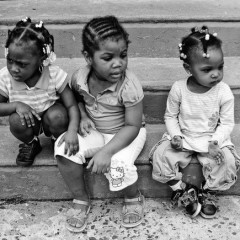Next City’s Storefront for Urban Innovation is currently home to a community based photo project by Philadelphia-based street photographer Tieshka Smith (to February 16). The exhibition, “Portraits of Brewerytown,” provides a thoughtful look into the North Philadelphia neighborhood and its inhabitants. Smith’s photos highlight leaders and long standing members of the community engaging in their projects and professions, giving the viewer a glimpse into the vital relationship these individuals have with their neighborhood. Her work confronts the area’s reputation as a crime and poverty-stricken neighborhood and counters this by focusing on the uniquely positive and vibrant personality of the population. “Portraits of Brewerytown” sheds light on the singular traditions and facets of this changing historical district.
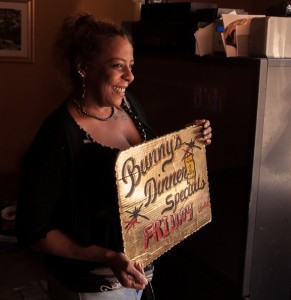
The exhibition is curated in clusters, broken into several sections separated by subject matter: The Rec Center and Education, Urban Farming, Business Corridors, Individuals and Street Scenes. Each image is accompanied by a caption describing the context of the photograph in a brief yet illuminating description.
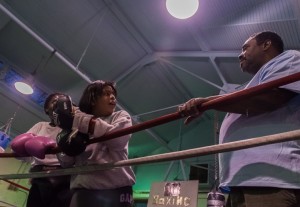
The Rec Center is the first grouping in the exhibit and an especially important part of the show and neighborhood. The Brewerytown Recreational Center offers everything from after school homework help to boxing lessons and is nationally recognized for producing several boxing professionals. An especially eye-catching image of two girls, Tyeara and Skylar, talking with Supervisor Fred Jenkins on a break from their training stands out within this first collection of images. This particular image, shot in color, balances the black and white images of the boys training at the Rec Center and mirrors the balance of the exhibition as a whole.

The Rec Center also holds an after school program, represented by an image of Ms.Diane, the overseer of the program, looking over the children’s homework. The description reads “She is the first person the students see when they walk through the doors of the Center every single day and is frequently greeted with hugs.” It is refreshing to see focus on community leaders such as Ms. Diane, that contribute so clearly to the development of a neighborhood’s youth and are all to often overlooked and under-appreciated.

The Business Corridors section of the show showcases portraits of local businesses and their owners, all of whom have long been essential pillars of the heart of Brewerytown. One portrait captures Jim Davis, the owner of Music Box Records, the immediate neighbor of Next City’s Storefront (I would encourage anyone who visits the show to also stop next door for an authentic and gratifying record shopping experience.)
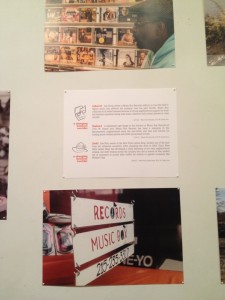
Music Box Records has been around since the 1990’s, and is likely to remain a fundamental part of Brewerytown’s local business world for decades to come.
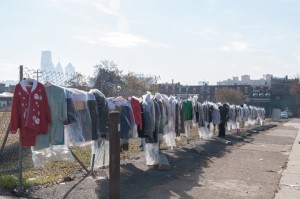
“Street Scenes” includes several images of a street sale run by a local man. He started this clothing bazaar of unclaimed items from local dry cleaners in an abandoned lot around the corner from Next City. The bazaar, with extensive options at cheap prices, brings residents from all over Brewerytown to sift through his wares. To some, that empty lot on the corner is just another forgotten space, but to those in Brewerytown it represents the tradition of a community event and something to look forward to.
The part of this exhibition that really sets it apart, however, is its interactive map element. A large map of Brewerytown towards the end of the show is labeled with the locations of all Smith’s photographs and visitors are encouraged to share and add their own stories with corresponding numbers on the map. These notes from the visitors and residents of the neighborhood are funny, sweet and sometimes heartbreaking.
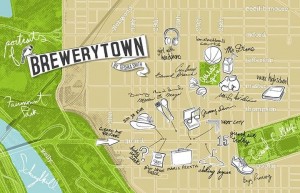
This interactive aspect brings this show beyond photographic art and journalism, beyond one-way information and into the realm of action. It offers the community of Brewerytown an opportunity to reconnect with their area and with each other, and to ease the transition of a developing district rich in history and tradition.

Tieshka Smith’s “Portraits of Brewerytown” does many things. It invites the viewer to discard preconceived notions of a neighborhood and to formulate their own opinions of a community, counterbalancing this negative portrayal with a heartwarming reality. It captures the personal relationships of an interwoven community that has held tradition generation after generation. It brings awareness to a marginalized population of vibrant and innovative individuals. It documents a historic neighborhood and its inhabitants through a transitional period of urban renewal and, most importantly, it becomes an exhibition not only about the residents of Brewerytown, but for them. Off the beaten path of the Center City gallery area, this show could be easily overlooked, but upon discovery it stands out as a multi-faceted gem equal to the neighborhood it celebrates.
Tieshka Smith’s “Portraits of Brewerytown,” on view at New City’s Storefront for Urban Innovation, 2711 Girard Ave. Closing reception for the show, Friday, Feb. 15, 2013, 5:30-8pm



